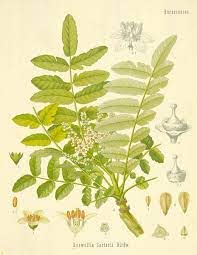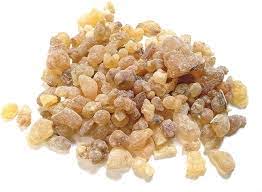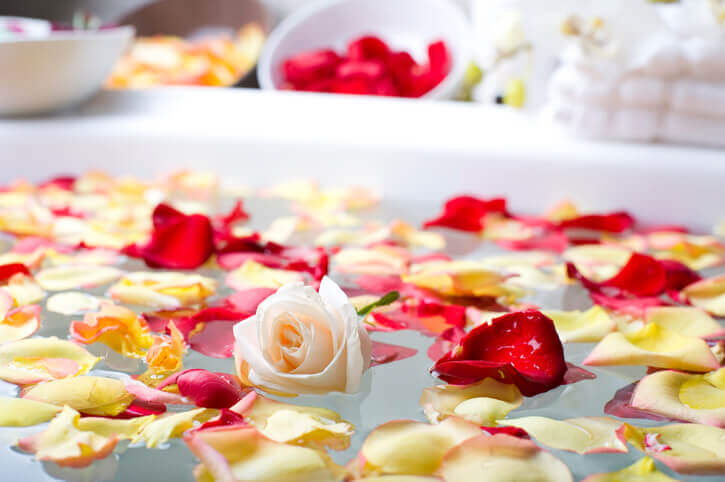The illustrious frankincense, or olibanum as it is also known, is obtained from an unspectacular scrubby tree of the genus Boswellia, native to the arid regions of Arabia and East Africa. Of the 25 species of tree producing frankincense gum resin, the most common are Boswellia carteri, found main in Somalia, Oman an Ethiopia, and Boswellia thurifera, Saudi frankincense.

In southern Arabia, the small trees (which reach 3-7m) are found scattered in dry, rocky gullies, formed into bizarre shapes by the sun and impoverished oil. For thousands of years, nomadic families have travelled into the desert to collect the resin by making incisions into the bark, causing the milky-white, liquid gum resin to exude. This hardens into amber or orange-brown 'tears' between the size of a pea and a walnut. The frankincense tears are scraped off into baskets and transported to ports to be shipped around the world.
Oil of Ages
The ancient Egyptians imported tonnes of frankincense and myrrh every year from the mysterious land of Punt, thought to be modern day Somalia, and through Jordan and Israel vis the famous Incense Route from Sabaía, the land of Queen Sheba (not Yemen and Oman). Frankincense was used by the Egyptians as a fumigant, ritual incense and medicine. As a cosmetic, the gum resin was charred and ground to make a black powder known as kohl, used by men and women to paint the eyelids.
Of its myriad uses, frankincense was favoured by ancient peoples as a treatment for wounds and skin diseases, urinary tract infections, gynaecological disorders, and as an expectorant for chronic catarrh. Frankincense also played a role in the religious and domestic life of the ancient Greeks, Romans, Babylonians, Persians and Hebrews. Today it's still a major ingredient in Jewish ceremonial incense, forming part of the Sabbath day offering.
For centuries it has been an important ingredient in incense mixtures burned in Roman Catholic and Greek Orthodox churches. In the past, it was thought that emotions, such as worry, grief and fear, created energies that affected the atmosphere in a room. Since people often left their distress in churches and temples, incense was used to cleanse the space on a psychic or subtle level.
Scientific Interest

In 1981, scientists in Germany were intrigued by reports that inhaling frankincense can be emotionally addictive to some people, such as alter boys. They found that when the gum resin (not the essential oil) is burned, it produces traces of tetrahydrocannabinol.
This psychoactive substance is said to enhance creativity and dream recall. Others have found that the balsamic aroma of frankincense, both the essential oil and the raw incense material, has the ability to deepen the breathing, which produces feelings of calm - a state inductive to prayer and meditation.
People in Arabic countries have always used frankincense for medicinal, as well as religious, purposes. For instance, they burn frankincense to relieve toothache, labour pain and to lower fever, while people suffering from rheumatism and arthritis suspend their painful joints in the smoke. A study at the University of Munich has demonstrated the anti-inflammatory effects of frankincense on joint pain. The remedy, known as Boswellia, is now sold in health stores, both as an ointment and as tablets for internal dosage. It contains boswellic acids extracted from frankincense gum resin.
Properties of the Oil
The essential oil is steam-distilled in Europe from the imported gum resin. It is pale yellow or greenish liquid with a warm, rich, sweet-balsamic aroma, often with a note of camphor. A high-quality oil will also reveal a lemony nuance. Its odour effect is intriguing: initially warming and mentally clarifying, giving way to a deeply relaxing sensation - all making it the supreme choice to facilitate meditation.
In aromatherapy, frankincense oil is valued for its beneficial effects on the respiratory system and may be used in steam inhalations, baths and massages for catarrh, bronchitis and coughs. The oil has also been recommended for asthma, though this should only be undertaken as part of a professionally supervised holistic healing programme.
Evidence among aromatherapists and their clients indicates that baths and massages with the oil can help reduce excessive menstruation associated with menopause. If the aroma is liked, it has a calming effect on the nervous system and may help with the emotional upheavals commonly experienced by women at this time of life.

For women's health problems, the rather 'masculine' fragrance is usually blended with rose, neroli and lavender.
With the current revival of interest in frankincense as a remedy for rheumatism and arthritis, it is certainly worth using the oil in the bath and in massage blends to help alleviate pain in muscles and joints. Aromatherapists recommend blending it with other anti-rheumatic and aroma compatible oils, such as juniper berry, lavender and rosemary.
Frankincense is regarded as a tonic with particular benefits to oily skin. It may also be used as a revitalising treatment for mature skins - although to counteract its possible drying effect, incorporate it into a cream base or dilute in a vegetable oil, such as avocado. Some aromatherapists believe that frankincense-based skin care products soften the appearance of wrinkles. While there is no scientific evidence to support this view, it's certainly worth a try.